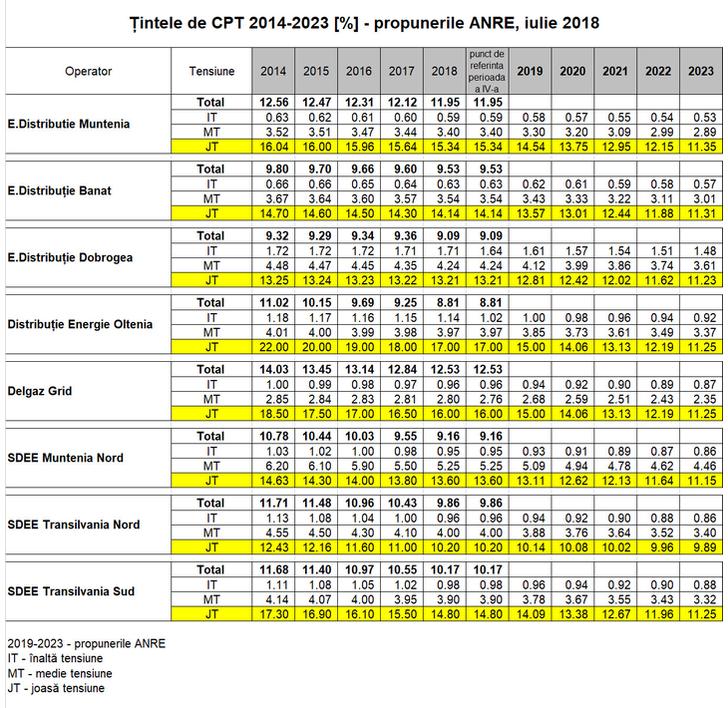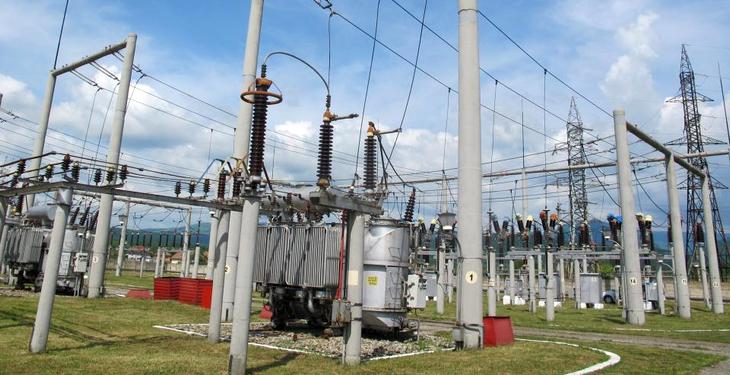The National Regulatory Authority for Energy has published its calculations for the future targets in CPT (own technological consumption) reduction in the electricity distribution networks for the period 2019-2023. All concessionary operators of power distribution grids are asked to substantially reduce grid losses over the next five years. The table published by the regulator includes the targets for each operator, proposed by ANRE, starting from a new Tariff Pricing Methodology for the electricity distribution service launched in public debate on July 21st. Companies have a few weeks time to dispute the ANRE project.
Data available on the ANRE website show that in 2023, the CPT in low-voltage networks should be close to 11% for seven of the eight distributors in Romania. The one exception is SDEE Transilvania Nord, which is expected to close below 10%, given that it has already achieved an 11% CPT level in the low voltage grid for 2017.
The biggest change compared to 2017 is calculated for Distribuție Energie Oltenia, part of the CEZ Group in Romania, which should reach 11.25%, compared to 18% (in 2017), an 38% gain. The operator announced for 2017 an 8.2% reduction in grid losses compared to 2016 – for a total CPT at 9.78%, compared to 10.60%, with indicators improved on high voltage grids (1.07, versus 1.18), medium voltage grid (3.97, versus 4) and on the low voltage area (17.08, compared to 19.14, in 2016). [Differences from figures in the ANRE table come from the fact that the table includes the targets for each year, while the company communicated the values actually achieved in each year.]
The level of losses depends on the quality of the grid (age and volume of investment in modernization and smart metering), as well as on geography (the length of the grid, relief differences etc.) and the relative welfare level of customers in the operating area network thefts) and the portfolio structure (industrial consumers, connected to the high voltage grid, respectively household consumers, connected to the low voltage grid). Energy Distribution Oltenia announced grid losses of about 917.8 GWh in 2017, of which it estimates that about 16% is “commercial losses”, that is thefts.
The synthetic table proposed by the regulator shows that the lowest level of total CPT was recorded in 2017 by Distribuție Energie Oltenia (9.25%), followed by E. Dobrogea – Enel (9.36%) and SDEE Muntenia Nord – Electrica (9,55%). In the case of SDEE Muntenia Nord, the total was pulled down by CPT on the medium voltage network (5.5% in 2017), the highest among the eight operators. In the case of E. Distribuție Dobrogea, CPT on the high voltage network was well above the levels of other distributors (1.71%).

For the year 2023, E.Distribuție Dobrogea would be asked to reach a CPT target at 1.48% on high voltage network (improved by 14% compared to 2017), still almost three times higher than the target level for E.Distribuție Muntenia (0.53) and E.Distribuție Banat (0.57).
Under the double condition that targets proposed by ANRE be adopted and then achieved, SDEE Muntenia Nord would reduce its CPT by 19% on medium voltage networks (at 4.46%); however, the indicator would still remain almost double than in the case of Delgaz Grid – E.ON, for which ANRE proposes a level of 2.35% in 2023, compared to 2.81% in 2017.
Technological own consumption is partially recognized by ANRE in the distribution tariffs applicable to all electricity consumers and is one of the main indicators of the quality of distribution networks, together with SAIDI (System Average Interruption Duration Index) and SAIFI (System Average Interruption Frequency Index).
CPT reduction programs are proposed by the distribution operators based on the projected investment volume over a 5-year period, the distribution network structure, the volume of equipment and distributed electricity. Reducing own technological consumption comes primarily to the benefit of distribution companies that improve their operational performance. However, this can only be achieved by investing hundreds of millions of euros annually, and the decision on the schedule of such spending must remain at operator level.
It is therefore expected a fierce battle with the regulator for each fraction of a percentage point in setting the CPT reduction targets. In addition, since grid investments are not only expensive but also complex, often extending for more than 12 months, operators are expected to require that the targets imposed by ANRE be not so tight related to yearly targets, at least for the first part of the 2019-2023 timeframe.

